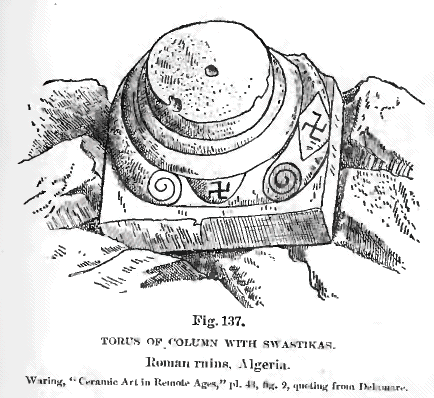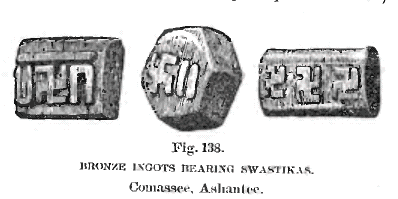

Dispersion of the Swastika
sometimes adorning the corners
of the tunics and togas as a large medallion, as shown in the figure.
(1)
Algeria.
Waring,
in his "Ceramic Art in Remote Ages," discoursing upon the Swastika,
 which
he calls fylfot, shows in pl. 43, fig. 2 (quoting from Delamare), the
base of a column from a ruined roman building in Algeria (fig. 137), on
the torus of which are engraved two Swastikas, the arms crossing at right
angles, all ends bent at right angles to the left. There are other figures
(five and six on the same plate) of Swastikas from a roman mosaic pavement
in Algeria. Instead of being square, however, or at right angles, as might
ordinarily be expected from mosaic, they are ogee. In one of the specimens
the ogee ends finish in a point; in the other they finish in a spiral
volute turning upon itself. The Swastika has been found on a tombstone
in Algeria. (2)
which
he calls fylfot, shows in pl. 43, fig. 2 (quoting from Delamare), the
base of a column from a ruined roman building in Algeria (fig. 137), on
the torus of which are engraved two Swastikas, the arms crossing at right
angles, all ends bent at right angles to the left. There are other figures
(five and six on the same plate) of Swastikas from a roman mosaic pavement
in Algeria. Instead of being square, however, or at right angles, as might
ordinarily be expected from mosaic, they are ogee. In one of the specimens
the ogee ends finish in a point; in the other they finish in a spiral
volute turning upon itself. The Swastika has been found on a tombstone
in Algeria. (2)
Ashantee.
Mr. R. B. Mcleod, of Invergordon Castle, Ross-shire, Scotland, reported (3) that, on looking over some curious bronze ingots captured at Coomassee in 1874, during the late Ashantee war, by Captain Eden, in whose possession they were at Inverness, he had found some marked with the Swastika sign (fig. 138). These

Classical
Occident --- Mediterranean.
Greece and the Islands of Cyprus, Rhodes, Melos, and Thera.
The
Swastika has been discovered in Greece and in the islands of Archipelago
on objects of bronze an gold, but the principal vehicle was pottery; and
of these the greatest number were the painted vases. It is remarkable
that the vases on which the Swastika appears in the largest proportion
should be the oldest, those belonging to the Archaic period. Those already
shown as having been found at Naukratis, in Egypt, are assigned by Mr.
Flinders Petrie to the sixth and fifth centuries B. C., and their presence
is accounted for by migrations from Greece.
The Greek and Egyptian meander
not the same as the Swastika. --- Professor Goodyear says: (4)
"There is no proposition in archæology which can be so easily
demonstrated as the assertion that the Swastika is originally a fragment
of the Egyptian meander, provided Greek geometric vases are called in
evidence."
Egyptian meander here means the Greek
fret. Despite the ease with which he says it can be demonstrated that
the Swastika was originally a fragment of the Egyptian meander, and with
all respect for the opinion of so profound a student of classic ornament,
doubts must arise as to the existence of the evidence necessary to prove
his proposition. Figs. 139,
140, 141
and 142
1. Forrer, "Die Gräber- und Textilfunde von Achmim- Panopolis." p. 20. [Back]
2. Bull. Soc. Francaise de mumism. ct d'archéol., II, pl. 3, p.3. Back
3. "Ilios," p. 353. Back
4. "Grammar of the Lotus," p. 352. Back
<< Previous Page Next Page >>
© 2004-2007 Northvegr.
Most of the material on this site is in the public domain. However, many people have worked very hard to bring these texts to you so if you do use the work, we would appreciate it if you could give credit to both the Northvegr site and to the individuals who worked to bring you these texts. A small number of texts are copyrighted and cannot be used without the author's permission. Any text that is copyrighted will have a clear notation of such on the main index page for that text. Inquiries can be sent to info@northvegr.org. Northvegr™ and the Northvegr symbol are trademarks and service marks of the Northvegr Foundation.

|